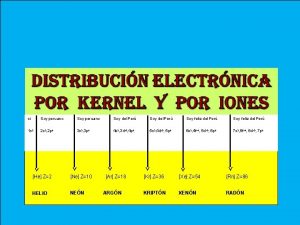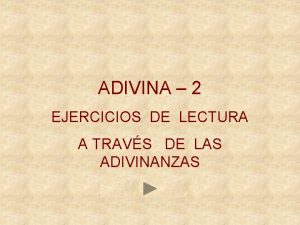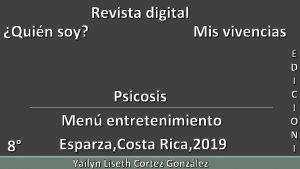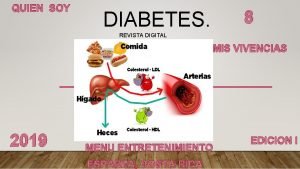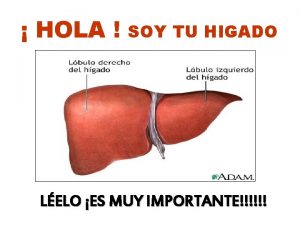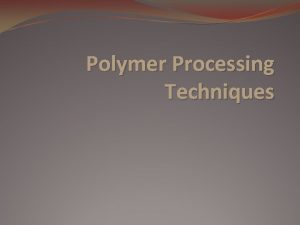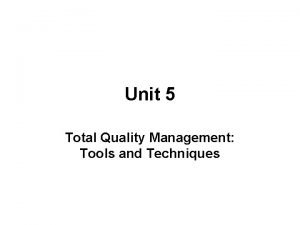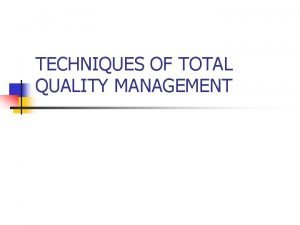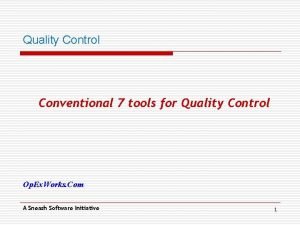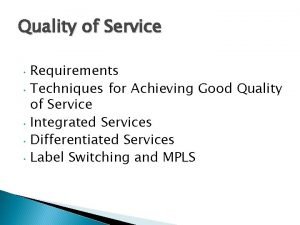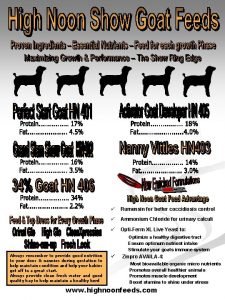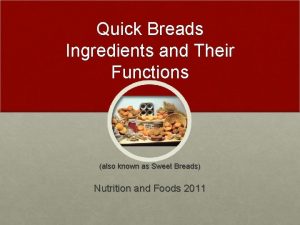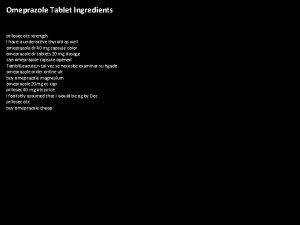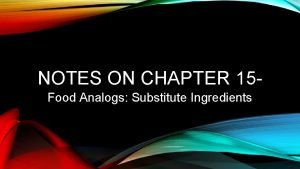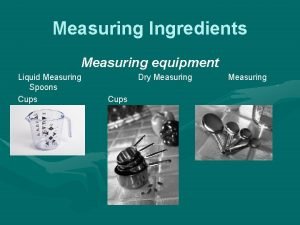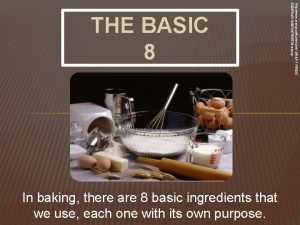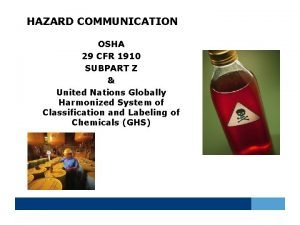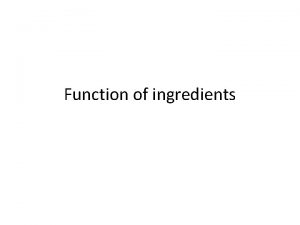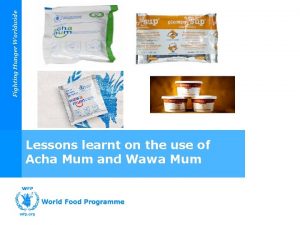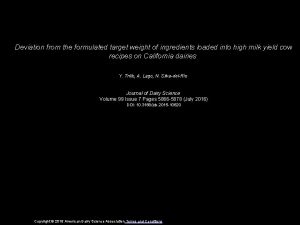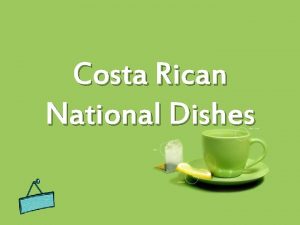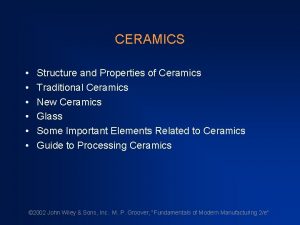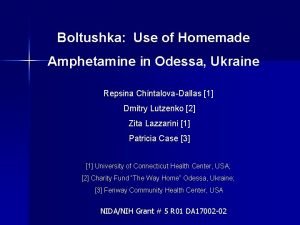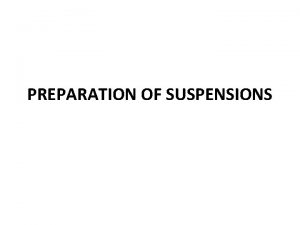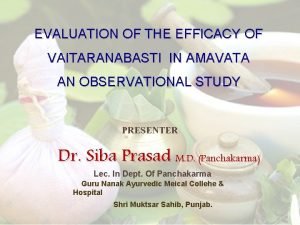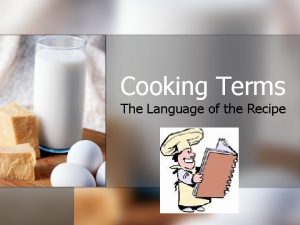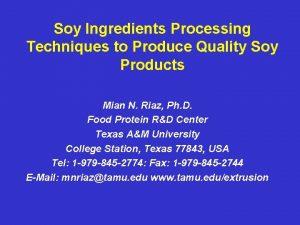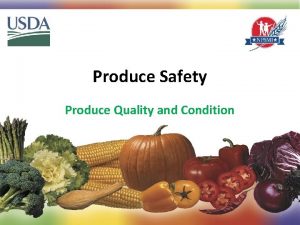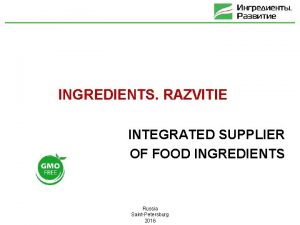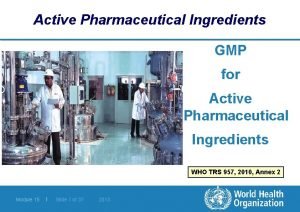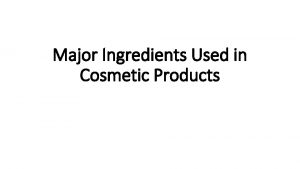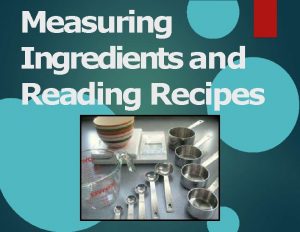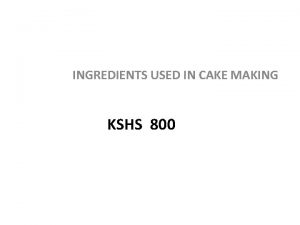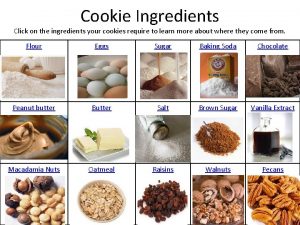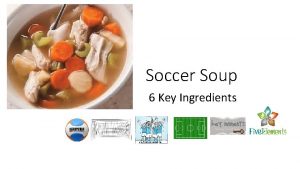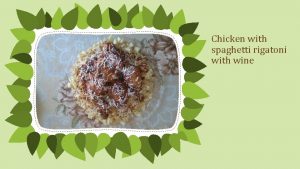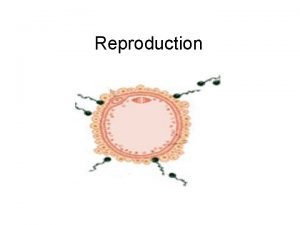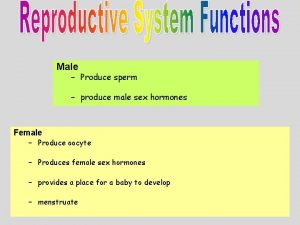Soy Ingredients Processing Techniques to Produce Quality Soy


















































































- Slides: 82

Soy Ingredients Processing Techniques to Produce Quality Soy Products Mian N. Riaz, Ph. D. Food Protein R&D Center Texas A&M University College Station, Texas 77843, USA Tel: 1 -979 -845 -2774: Fax: 1 -979 -845 -2744 E-Mail: mnriaz@tamu. edu www. tamu. edu/extrusion

Soy and Consumers • Five to seven year ago, the average consumer was not aware of soy’s health benefits • Today the word “soy” is on everyone’s lip • As we enter into new millennium soybeans are becoming increasingly popular

Soy and Consumers • Not so long ago, soy was a “bad” word among manufacturers • Perhaps the reason was a stigma with soy having a negative taste and smell • Maybe lack of scientific evidence • Consumer awareness about the nutritional values of soy

Benefits of Modern Soy Products • Soy concentrates and isolates are easily digested by humans • Soy protein is equal the quality of milk meat and eggs protein • Soy proteins are acceptable in almost all diets • Soy protein contain virtually no cholesterol and it is lactose-free • Soy proteins are lower in fat

Soy and Food Industries • Several food industries are working to bring soy foods to the consumer • Rather than depending upon the consumers to seek them out • Conventional breads, snacks, cracker and breakfast cereals to which soy has been added

Soybean’s Processing • How do we reach from soybeans to quality Soy products?

Raw Soybeans • Raw soybeans can not be used successfully in human foods, unless processed properly • There are several anti-nutritional factors which have been identified in raw soybeans • We must eliminate, destroy or reduce these factors in order to utilize the soybeans

Processing of Soybeans • In order to use soybeans into different food products, soybean can be processed in to different soy ingredients • The first step is cleaning and dehulling the soybeans in order to use for food applications

Cleaning of Soybeans • Soybean cleaning is important for producing high quality end products • As well as protection of equipments • Cleaning is done on sieves under air aspiration • Dust, plant tissue, pebbles and light contaminated material as well as bigger impurities like stones, stem, nail etc are separated

Drying of Soybeans • Soybeans are dried in grain driers to a moisture level of 10% • This level of moisture is required for proper dehulling • Temp. of the dryer should be 70 -76 C • Uniform drying of the soy is very important for removal of hulls • We need to remove the hulls from every individual beans not an average

Drying of Soybeans • To do a good job of hull removal: • It is essential to subject the beans for some kind of thermal impact • This is necessary because the hulls are attached to the bean with a proteinatious material • Heat affect release the hulls

Tempering of Soybeans • After drying the beans are stored for tempering approximately for 72 hours • This help to stabilize the moisture contents in the beans • Dried soybeans are usually cleaned again to remove as much loose hulls pods, sticks and other foreign material as possible • This step increase the efficiency of the cracking rolls and aspirators

Cracking and Dehulling of Soybeans • The objective of cracking is to break the soybean into suitable pieces for dehulling and flaking • Dried soybeans are cracked by using cracking mills • Bean are broken into smaller pieces • After cracking, the hulls are separated under air-flow and the lighter hulls are withdrawn

Cracking and Dehulling of Soybeans • It is important at this point to understand exactly how air separation work • With properly dried and cracked soybeans, the cotyledons should separate easily from the hulls • Soybean contain about 8% hulls by weight • From practical point of view it is not possible to get an absolute separation of hulls from cotyledons

Processing of Soybeans into Soy Ingredients • • • Soy Flours Soy Concentrates Soy Isolates Soy Fiber Soy Isoflavones

Soy Flours • There are three main categories of soy flour available in the market for different food application • Full Fat Soy Flours • Soy Flours (defatted) • Partially Defatted Soy Flours

Full Fat Soy Flours

Full Fat Soy Flour • Under this category there are 3 types of flour available in the market • Enzyme-Active Soy Flour • Toasted Full Fat Soy Flour • Extruded Processed Full Fat Soy Flour

Enzyme-Active Soy Flour • Dehulled soybeans are ground by a hammer mill or by an impact pin mill into flour with desired particle sizes. • Full fat products are difficult to pulverize or sieve

Production of Enzymes Active Soy Flour Soybeans Hulls Cleaning Cracking Dehulling Soy Chips Grinding Enzymes Active Soy Flour

Enzymes-Active Soy Flour • This flour contain: • • Protein 40 % Moisture 10 % Fat 20% Granulation less than 1% on U. S. No. 45

Toasted Full Fat Soy Flour • Toasted full fat soy flours are also called “heat-treated full fat soy flours” Cleaned soybeans are steamed for 20 -30 minutes under slight pressure, then cooled, dried, cracked, and aspirated to remove the hulls

Production of Toasted Soy Flour Soybeans Cleaning Toasted Soy Flour Steaming Hulls Drying, Cracking Dehulling Soy Chips Grinding

Production of Full Fat Soy Flour Cleaned, dehulled/flaked/ground soybeans are processed through wet or dry extruder to stabilize the enzymes activities After extrusion material is dried (if wet extruder was used), cooled and ground to flour

Production of Full Fat Soy Flour by Dry Extrusion Soybeans Hulls Full Fat Soy Flour Cleaning Cracking Dehulling Soy Chips Grinding Dry Extrusion Cooling

Production of Full Fat Soy Flour by Wet Extrusion Soybeans Hulls Full Fat Soy Flour Cleaning Cracking Dehulling Soy Chips Dry/Cool/Grind/Flake Extrusion

Full Fat Soy Flour • • This flour contain Protein 38 -42% Fat 18 -20% Crude Fiber 3. 5 -4%

Uses of Full Fat Soy Flour • • Bakery Products Soy Breads Cakes and doughnuts Sweet Goods Chocolate and Confectionery Spreads Wafer Fillings

Soy Flours (Defatted)

Soy Flour • There are 2 different types of soy flour available in the market to be used in different foods Defatted Soy Flour Textured Soy Flour

Soy Flour • Soy Flour The finely powdered material resulting from the screened and graded product after removal of most of the oil from selected, sound, clean and dehulled soybeans by solvent extraction process

Soybeans Production of Defatted Soy Flour Cleaning Cracking Soy Cotyledon Conditioning and Flaking Full Fat Flakes Solvent Extraction Solvent Removal Defatted Flakes Soy Flour Grinding

Conditioning of Soybeans • Cracked and dehulled soybeans are conditioned in cooker to approximately 70 C with steam • Small amount of water can be added to adjust the moisture to approximately 11%, which make the beans ideal for flaking • The function of the conditioning is to facilitate the flaking step

Flaking of Soybeans • In order to extract the oil from the beans it is important to destroy the cell structure of the beans • To achieve this bean are flaked in the flaking machine • Since solvent can much more readily flow through a bed of flakes then through a bed of soy meats or fine particles

Flaking of Soybeans • The ideal thickness of a flakes is in between 0. 25 to 0. 35 mm • Thickness of these flakes will depends upon the size of the cracked beans • Conditioning • Adjustment of the flaking rolls

Extraction of Flakes • Now flakes are ready for extraction • Soy flours, soy concentrates and soy isolates typically are made from flakes • Soy flakes are fed into solvent extractor • This process reduce the residual oil to low level in flakes

Types of Extractors • There are several different types of extractors used by the industry • Classified by bed depth: • Deep bed extractor – over 3 ft deep or over 30: 1 length to depth ratio • Shallow bed extractors

Types of Extractors • Classed by extraction principle • Percolation • Immersion

Extraction of Flakes • After sufficient contact time with the solvent (hexane) these flakes are desolventized to remove the residual hexane

Meal Desolventization • Desolventizer-toaster (DT) – Common for animal feed use • Flash Desolventizer System (FDS) – Common if meal is to be used for concentrates or isolates production • Vapor Desolventizer – Similar in principle to the FDS

Desolventizer-Toaster (DT) • In this system flakes are desolventized in standard desolventizer-toaster (DT) • It uses live steam to derive the solvent off

Production of Soy Flour • Defatted flakes are milled using hammer mill to produce soy flour • At least 97% of the flour must pass through a U. S. Standard No. 100 sieve • This flour contain 52 -54% protein as is

Soybeans Production of Defatted Soy Flour Cleaning Cracking Soy Cotyledon Conditioning and Flaking Full Fat Flakes Solvent Extraction Solvent Removal Defatted Flakes Soy Flour Grinding

Expanding of Flakes • Recently, several soy flour, concentrates and isolates producing companies start using expanderextruder after the flaking step and before the extraction • Use of expander was originally was developed from Brazil and then was introduced in U. S. in early 1980

Soybeans Production of Defatted Soy Flour Cleaning Cracking Soy Cotyledon Conditioning and Flaking Full Fat Flakes Wet Extrusion Solvent Extraction Solvent Removal Soy Flour Grinding Defatted Flakes

Benefits of Expanders • According to Watkins et al, use of expander offer several advantages in processing soybean for extraction • The seed is finely homoginized in the expander, freeing the oil for rapid extraction • Dense collects are formed (weigh more per cubic foot)

Benefits of Expanders • The collects are porous, and do not restrict percolation of solvent through the extractor bed, as it may occur with fragile flakes • Results in better and faster extraction • More oil is recovered by solvent from collect as compared to flakes

Benefits of Expanders • The solvent drains more completely from the extracted collects, resulting in more complete removal of oil • Sturdier than flakes so they generate less fines • Less energy is required for desolventizing the collects compared to flakes

Textured Soy Flour Soy flour that has texture imparted either by spinning a fiber and combining the fiber in layers to achieve the desired texture, or, by a thermoplastic extrusion process. Please note that TVP (textured vegetable protein) is a trademark of the Archer Daniels Midland Company

Partially Defatted Soy Flours

Partially Defatted Soy Flour • There are 2 different types of partially defatted soy flour available in the market for food applications • Mechanically Processed Soy Flour • Refatted or Relecithinated Soy Flour

Mechanically Processed Soy Flour • Full fat soy flour while it is still hot is fed to continuous expeller to reduced the oil.

Preparation of Mechanically Expelled Soy Flour Whole Soybeans Soybean Flour Dehulled Grinding Cotyledons Press Cakes Extruding Extrudates Pressing

Application of Mechanically Expelled Soy Flour • • • This flour usually contain Protein 46 -48% Oil 6 -9 % oil Crude Fiber 3 -4% PDI 25 -30 This flour is used for making textured soy protein • Also used for protein fortification in different food application like, tortilla breads, etc

Refatted or Relecithinated Soy Flours • Soy flours are refatted to a level of 1 to 15% added fat to reduce the dustiness • To provide fat for product formula • Relecithinated soy flours are produced with 3, 6 and 15% added lecithin • Lecithin improves dispersion of the flour and other admixed ingredients in confection and cold beverage products.

Flow Diagram for Manufacture of Full-fat and Enzymes Active Soy Flours Cleaned Whole Soybeans Tempering Cooking Cracking, dehulling Milling, classification Drying, cooling Cracking, dehulling Milling, classification Enzyme-Active Full. Fat Soy Flour Full-Fat Soy Flour, Grits

Flow Diagram for Manufacture of Low Fat and Defatted Soy Flours Cleaned Whole Soybeans Tempering Cracking, dehulling Flaking Screw pressing Solvent extraction Flash desolventization, toasting Milling, classification Drying, cooling Milling, classification Low-Fat Soy Flour, Grits Defatted Soy Flour, Grits

Soy Concentrates

Production of Soy Protein Concentrates (SPC) • Defatted flakes or soy flour are used as starting material • SPC are processed selectively by removing the soluble carbohydrates from soy protein flour • The removal take place by aqueous alcohol or isoelectric leaching

Production of Soy Protein Concentrates (SPC) • There are several different methods to produce soy concentrates • Extraction of flakes with aqueous 20 to 80% ethyl alcohol • Acid leaching of flakes or flour • Denaturing the protein with moist heat and extraction with water

Preparation of Soy Protein Concentrates from Defatted Flakes Defatted soy Flakes Aqueous Alcohol leach (60 -80%) Dilute acid leach (p. H 4. 5) Moist heat Neutralize Water leach Insoluble fraction Spray-dry Soy protein concentrates

Flow Diagram of Soy Protein Concentrate Production by Aqueous Alcohol Extraction Flakes alcohol-water Sugar extraction by aqueous alcohol-water soy solubles Soy Solubles Alcohol-water wet flakes Desolventize Evaporate alcohol-water Distill Water-wet flakes Dry Water Soy protein concentrate Alcohol Water Source: Campbell, et al

Production of Soy Protein Concentrates (SPC) • SPC contain at least 65% protein • During processing of SPC objectives are to immobilize the protein while leaching away the soluble, removing the strong flavor components and the flatulence sugars (sucrose, stachyose, and raffinose) • In turn, both protein and dietary fiber contents are increased

Production of Soy Protein Concentrates (SPC) • Alcohol extraction is considered to produce the blandest products • Mild heat drying conditions are used in acidic water extraction process to retain high PDIs

Textured Soy Protein Concentrate Soy protein concentrate that has texture imparted by spinning a fiber in layers to achieve the desired texture, or, by a thermoplastic extrusion process.

Soy Isolates

Production of Soy Protein Isolates (SPI) • There are several ways that can be used to produce SPI • But the only commercial procedure currently being used is: • Extraction of defatted soy flakes or flour with water, followed by centrifugation • In this process the protein is solubilized at p. H 6. 8 -10 at 27 -66 C by using sodium hydroxide and other alkaline agents approved for food uses

Production of Soy Protein Isolates (SPI) • The protein solution is then separated from the flakes or flour by centrifugation. • The solids are recovered as a by-products containing 16 -36% protein, 9 -13% crude fiber and 45 -75% total dietary fiber when dried to 6 -7% moisture content and can be marketed for food uses

Production of Soy Protein Isolates (SPI) • The solution is then acidified to p. H 4. 5, by using hydrochloric acid or phosphoric acid and the protein is precipitated as a curd • The curd is then washed with water and then concentrated by centrifugation and can be neutralized to p. H 6. 5 -7. 0 or spray dried in its acidic form

Production of Soy Protein Isolates (SPI) • SPI, the most concentrated form of soy protein available • SPI contain 90% protein

Composition of Soy Protein • Soy Protein products encompass a range of protein levels Composition of Soy Protein Products Full-fat Soy Constituent Flours & grits Defatted Flours and Grits Soy Protein Concentrates Isolated Soy Protein % As Is ______________________________________________ Protein (N x 6. 25) Fat Crude Fiber Ash Moisture Carbohydrates (by difference) 38 - 42 18 - 20 7 - 10 4 -5 5 -8 28 - 32 52 - 54 0. 5 - 1. 0 2. 5 - 3. 5 5 -6 6 -8 30 - 32 62 - 69 0. 5 - 1. 0 3. 4 - 4. 8 3. 8 - 6. 2 4 -6 19 - 21 86 - 87 0. 5 - 1. 0 0. 1 - 0. 2 3. 8 - 4. 8 4 -6 3 -4

Use of Soy Protein • Soy Protein are used for a variety of food, nutritional and industrial applications Isolated Soy Proteins Soy Protein Concentrates Soy Flour/Grits Soy Flour Defatted Textured Full Fat __________________________________________________ Baking 2% 59% 90% Meat Extension/Alternative 20% 49% 2% 95% Pharmaceutical 9% Functional Foods 10% 5% 2% 5% Protein Extraction 8% 5% Animal/Pet Food 30% 14% 5% Dairy Replace. /Infant Foods 40% 5% Industrial Applications 18% 5% Miscellaneous Application 11% 6% 6% ____________________________________________ 100% 100% Source: U. S. Soyfoods Market, Soyatech, Inc.

Production of Soy Fiber • There are two types of soy fiber available in the market for food application • Soy Fiber from soy hulls • Soy fiber from soy cotyledons

Soy Fibers from Soy Hulls • Also called soy bran • During soybean processing hulls are removed, washed, sterilized, dried toasted and ground to different sizes, depending upon the application • Used in breads, cereal and snacks

Soy Fibers from Cotyledons • During the production of soy isolates, the insoluble protein is separated by centrifugation • These solids are very similar to okara products obtained during soy milk or tofu production • Only difference is that they do not contain any hulls, and have been defatted and treated with mild alkali

Soy Fibers from Cotyledons • After appropriate purification, this material is dried and sold as soy fiber. • Mainly used in beverages, puddings, retorted soups etc • Also used in baked breads, muffins, crackers, cookies or breakfast bars

Soy Isoflavones

Production of Soy Isoflavones • There are two main processed used by the industry to produce soy isoflavones • 1. Chemical Extraction • 2. Mechanical Extraction

Soybeans Hulls Chemical Extraction Cleaning Cracking Dehulling Soy Chips Solvent Extraction Flour Concentrates Isolates By-Products Soy Molases Chemical Extraction

Soybeans Cotyledon Mechanical Extraction Mechanical Separation Of Germ 20 X Roast Mill Flour Germ Flour Protein 40%; EFA; Lecithin Vit. E; 20 time more Isoflavones

Texturized Soy Protein • Texturized soy protein “TSP” typically mean defatted soy flours or concentrates, mechanically processed by extruders to obtain meat-like chewy texture when rehydrated and cooked.

Raw Material for TSP • • • Most common raw material for TSP is Defatted Soy Flour Soy Concentrates Partially Defatted Soy Flour Soy Isolate and some other ingredients
 Sophisticated printer used to produce high-quality drawings
Sophisticated printer used to produce high-quality drawings What is output devices
What is output devices Si soy peruano soy peruano
Si soy peruano soy peruano Rima con morena
Rima con morena Adivinanzas de
Adivinanzas de Soy un hombre feliz
Soy un hombre feliz Sunflower vs soy lecithin
Sunflower vs soy lecithin Cargadas van cargadas vienen
Cargadas van cargadas vienen Yo soy de costa rica entonces soy
Yo soy de costa rica entonces soy Yo soy de costa rica entonces soy
Yo soy de costa rica entonces soy Andalucia es mi tierra yo soy del sur ecos del rocio
Andalucia es mi tierra yo soy del sur ecos del rocio Eres un higado
Eres un higado Si soy debil entonces soy fuerte
Si soy debil entonces soy fuerte Bottom up and top down processing
Bottom up and top down processing Bottom up processing vs top down processing
Bottom up processing vs top down processing Bottom up and top down processing
Bottom up and top down processing Neighborhood processing in digital image processing
Neighborhood processing in digital image processing Primary processing and secondary processing
Primary processing and secondary processing Fractal image
Fractal image Histogram processing in digital image processing
Histogram processing in digital image processing Parallel processing vs concurrent processing
Parallel processing vs concurrent processing Nonlinear image processing
Nonlinear image processing Image processing
Image processing Thinning and thickening in image processing example
Thinning and thickening in image processing example Top-down processing example
Top-down processing example Interactive processing
Interactive processing Plastic processing techniques
Plastic processing techniques Histogram
Histogram Sketch techniques for approximate query processing
Sketch techniques for approximate query processing Tissue processing steps in histopathology
Tissue processing steps in histopathology Point processing techniques
Point processing techniques Fonctions et solutions techniques
Fonctions et solutions techniques Quality tools and techniques
Quality tools and techniques Tqm techniques
Tqm techniques Sqa tools and techniques
Sqa tools and techniques Quality assurance coaching techniques
Quality assurance coaching techniques Quality controls for conventional techniques
Quality controls for conventional techniques Apply quality control
Apply quality control Data quality control techniques
Data quality control techniques Quality control tools and techniques in project management
Quality control tools and techniques in project management Project quality plan
Project quality plan Techniques for achieving good quality of service
Techniques for achieving good quality of service Quality assurance vs quality control
Quality assurance vs quality control Quality control vs quality assurance pmp
Quality control vs quality assurance pmp Pmbok quality management
Pmbok quality management Process of nursing audit
Process of nursing audit Compliance vs quality
Compliance vs quality Concept of quality assurance
Concept of quality assurance Which one is jurans three role model
Which one is jurans three role model Crosby's fourteen steps to quality improvement
Crosby's fourteen steps to quality improvement What is tqm
What is tqm Asea via
Asea via Dooshivishari agada ingredients
Dooshivishari agada ingredients Promatogram
Promatogram Noco excel ingredients
Noco excel ingredients Asea renu 28 ingredients
Asea renu 28 ingredients Classification of quick bread
Classification of quick bread 3-2-1 pie crust
3-2-1 pie crust Omeprazole 40 mg coupon
Omeprazole 40 mg coupon Chapter 15 food analogs substitute ingredients
Chapter 15 food analogs substitute ingredients Angioprim ingredients
Angioprim ingredients Measuring ingredients worksheet
Measuring ingredients worksheet 8 basic ingredients in baking
8 basic ingredients in baking Ice power active
Ice power active 3 ingredients for fire
3 ingredients for fire Functions of ingredients
Functions of ingredients Acha mum
Acha mum Enzymes in food
Enzymes in food Deviation ingredients
Deviation ingredients Gallo de picadillo
Gallo de picadillo Traditional ceramics examples
Traditional ceramics examples Catalytic converter ingredients
Catalytic converter ingredients Boltushka drug
Boltushka drug A positive friendship recipe might include
A positive friendship recipe might include Cleangredient certified ingredient
Cleangredient certified ingredient Universal ingredients of human communication
Universal ingredients of human communication Chef's salad is an example of a _____ salad.
Chef's salad is an example of a _____ salad. Ingredients for suspensions
Ingredients for suspensions Soap making ingredients and procedure
Soap making ingredients and procedure Ingredients of friendship
Ingredients of friendship Vaitharana vasti
Vaitharana vasti Project bakeover (2021) télécharger
Project bakeover (2021) télécharger To combine two mixtures by gently cutting down
To combine two mixtures by gently cutting down


